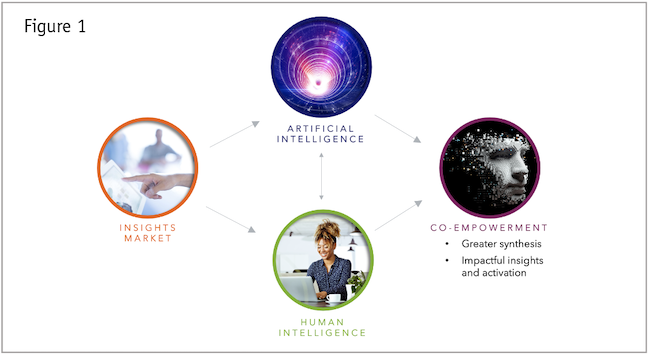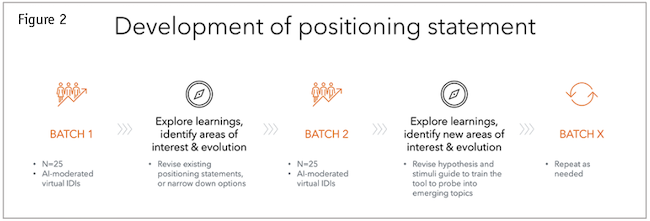Better together
Editor's note: Casey Mohan Schulz is vice president, qualitative insights and strategy at CMB. Richard Scionti is vice president, product development and innovation at CMB.
The power of combining qualitative and quantitative research cannot be understated and is long-supported. However, what if we could integrate the best of both worlds in a way that’s not only more impactful but more efficient? This is where qualitative research at scale (qual@scale) enters the conversation.
Conducting qual@scale offers researchers many benefits. Thanks to AI, qual@scale fits between traditional qualitative and traditional quantitative research skills and approaches. Researchers can use larger qualitative sample sizes to design research that answers pressing business questions in a more relevant and timely manner than traditional methods alone.
From statistical significance to cost efficiencies, integrating qual@scale is a dynamic way to guide business decisions and support the exploration of business challenges in today’s rapidly evolving landscape. While it feels like AI is taking over, from our vantage point, AI is only as good as the people steering it. The fusion of human intelligence (HI) and AI creates a “co-empowerment” that opens a breadth of opportunity for synthesis, insight and insight activation (Figure 1).

Nuances and epiphanies
Larger sample sizes on qualitative data help researchers gain a comprehensive understanding of consumer behavior, preferences and attitudes. Capturing data at scale is just one piece of the puzzle. AI and HI enable researchers to better analyze, understand, categorize and synthesize data, further exploring its nuances and epiphanies in an iterative fashion.
This is a huge advantage for insights professionals and is why qualitative and quantitative research pairs so well. It helps businesses and stakeholders develop more identification of trends and patterns, without compromising the empathetic lens that qualitative research brings to insights. When qualitative is conducted at scale, researchers can confidently identify trends without losing the rich stories that are emblematic of qualitative research to maintain a holistic view of an audience. This marriage between qualitative and quantitative also helps to ensure that organizations are moving forward with confidence, centering on authentic, engaged customer voices.
Qual@scale also helps us broaden who we hear from in research and enables more iterative approaches to qualitative research, as qual@scale is significantly more adaptive. Too often we limit insights to a specific demographic or segment. With qual@scale, larger sample sizes help ensure that findings are representative of a broader demographic and this diversity enriches learnings and builds further confidence in the insights. Additionally, larger sample sizes help researchers defend learnings, empowering researchers to assert their findings and provide insights that can be relied on for strategic decision-making.
Conducting qual@scale offers strategic advantages along with cost advantages. Researchers can maximize the value of their investment by finding the right blend of large sample sizes and qualitative activities and questions. This helps to ensure that multiple voices are heard and the humanistic activities are elevated in your insights.
The ability to support researchers as they nimbly identify emerging trends is a huge benefit of qual@scale. Qualitative is well-known for its ability to navigate white space and doing so at scale builds confidence in the ongoing shifts in consumer attitudes and/or behaviors. This allows researchers a clear path to learning in an adaptive fashion, identifying nuances and then evolving focus to explore as areas of interest emerge. Conducting qual@scale can be an effective method for micro-exploration, helping organizations stay ahead of trends and market shifts and shifting from a reactive to proactive approach. Figure 2 is an example of how qual@scale can be used for iterative research.

Consider key elements
Conducting qual@scale requires careful planning and steadfast execution to ensure researchers deliver strategic actionable insights. As a research team exploring qual@scale, it’s important to consider key elements like sampling strategy and sources, tools used for data collection and analysis, quality assurance measures and flexibility in research plans. These focal points will help to ensure that efforts generate actionable insights and evolve stakeholders’ thinking and understanding of consumer behavior.
As alluded to, qual@scale should be designed with an iterative lens. Today, businesses are tasked with keeping up with evolving consumer behavior at a pace that moves faster than ever. An iterative approach to integrated insights helps organizations move forward flexibly and in a manner that keeps pace with market evolutions, enabling human- and data-centric decisions that drive businesses forward.
Sample is a critical foundation of good qualitative research and qual@scale is no exception. While industry publications have long touted trusted insights as the North Star, the quality and relevance of the people we’re talking to are foundational to the insights we deliver. As qualitative research scales, researchers are faced with a new but familiar challenge: getting the right people in the “room”…at scale. As sample sizes increase, researchers are often faced with the challenge of finding enough of an audience. These participants not only have to meet screening criteria related to demographics and psychographics but also thresholds of articulation needed to complete qualitative activities. Recruitment processes and engagement monitoring also need to scale and doing so effectively and at a reasonable expense requires strategy, collaboration and rock-solid project management. There are many paths to recruiting at scale with considerations including balancing across the spectrum of traditional qualitative recruitment to quantitative panel sample to achieve qual@scale without compromising the richness of qualitative samples. This may include blending of sample sources, engagement styles and collection methodologies. All this included provides the potential for better projectability and representation, with a focus on audience-based cost efficiencies.
Limited functionality
One issue is that qualitative tools are not always built for qual@scale and survey platforms offer limited functionality for qualitative data, even with the best plug-ins. When choosing tools to support qual@scale, it’s important for researchers to consider which features and functions best align with their unique research needs and stakeholder goals. A few areas to explore include:
Scalability: Ensure that the tool chosen can manage the volume of data being collected and includes features that help researchers automate engagement and analysis.
Flexibility: Tools for qual@scale should let researchers capture both structured quantitative data and open-ended qualitative data. And while data capture is important, the backend is just as important for researchers.
Similarly, qualitative processes are not always built for qual@scale and there are important procedural considerations researchers are well served to think through before engaging in qual@scale.
Collaboration: In today’s iterative landscape, it’s important for researchers to define collaborative functions of available tools and technology, as well as define collaborative processes for teams conducting qual@scale. Qual@scale can be conducted as a standalone ad hoc initiative or built into programs that support strategic decisions in an agile fashion. To keep up with evolving competitive landscapes and consumer needs, researchers can bring qual@scale to agile programs – addressing business challenges with both empathy and data to substantiate themes surfaced in the qualitative research.
Experienced project teams: As said before, insights are only as good as the participants and program around them. An adept project team who’s well versed in conducting qual@scale can help an organization identify the right tools and technology, design the right research program for data capture and enact strategies to maximize engagement and evolve guides. This enables companies to conduct the right kind of analysis to address business challenges, while also keeping pace with evolving competitive landscapes. It will also help to manage the people involved – recruiters, respondents, clients and project teams – to establish the right channels and cadence for communication.
Visualization is a crucial vehicle
Reporting is a crucial element of qual@scale; blending data and emotion is an art not a science. Analysis tools should offer capabilities like coding and categorization, provide emotional analysis and let researchers analyze structured quantitative datasets. As analysis moves from synthesis to reporting, visualization is a crucial vehicle for storytelling. Storytelling is what helps researchers deliver actionable insights. As research is being designed, researchers should consider how they envision the data and activities will be analyzed. Perceptual maps, charts, graphs and qualitative frameworks are all fair game when qualitative research is conducted at scale. Data visualization helps researchers elevate insights and communicate complex findings in accessible, easily digestible ways.
To ensure qual@scale is actionable, and to help improve your speed to insights, explore data from multiple lenses, including:
Thematic analysis, which is a sweet spot for agile research and qual@scale. AI can quickly pick up identification of recurring themes but can also identify nuanced themes and sub-themes that are more nascent, making pattern-solving challenges a great fit for qual@scale. AI enables researchers to produce nuanced analysis of qualitative data with speed and precision.
Emotional analysis is another unique offering of integrated insights and is most rich and accessible from qualitative data. When emotion is captured and analyzed at scale, it unlocks a new perspective – an empathetic lens that can break through boardrooms and inspire change and innovation.
Insights with an impact
Qual@scale is an innovative means for keeping up with the pace of change without compromising the quality of research. As researchers employ qual@scale at your organization, remember to infuse HI into the process, scale with agility and iterativity in mind, rigorously maintain data quality and deliver insights with an impact.